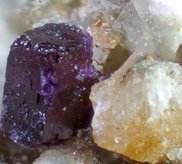
June Editorial
Putnisite - a new mineral for your database.

June Editorial
Putnisite - a new mineral for your database.
|
|
Geology is a well-established science, so new minerals are no longer discovered with any great frequency. In fact sometimes new minerals are only discovered because geologists have not been able to get to them before. This was the case with the Allende meteorite, which resulted in the discovery of the new mineral Panguite in 2012. However, sometimes geologists looking for other minerals still come across new ones right on planet Earth. This is the case with Putnisite (SrCa4Cr83+(CO3)8SO4(OH)16·25H2O), a strontium calcium chromium sulfate carbonate. It's the world's most newly discovered mineral, found on a volcanic rock at a mining site in Western Australia. Analysis confirmed that the chemical composition and crystalline structure of putnisite is unlike that of any known mineral. This novel mineral was discovered in a mine on the Polar Bear Peninsula, in the gold-rich area of Lake Cowan, about 550km east of the city of Perth. Miners working for a prospecting company came across the bright pink grains and sent them for further investigation. The grains arrived at the Commonwealth Scientific and Industrial Research Organization (CSIRO), and from there ended up on the table of Peter Elliott, a research associate with the South Australian Museum. Elliott's investigation showed that indeed putnisite was a previously unknown mineral. As he reported: "A mineral is different from currently known minerals if it has either a different chemical composition or it has a different crystal structure, or sometimes both… Putnisite, a strontium calcium chromium sulfate carbonate, has both a unique chemical composition and a unique crystal structure." Putnisite forms isolated pseudocubic crystals which are up to 0.5 mm in size. They are found on a matrix composed of quartz and a near amorphous (having no definite or clear shape or form) chromium silicate. The mineral is soft (Mohs hardness 1.5-2. The hardness of a fingernail on the Mohs scale is about 2.5) and brittle. The colour varies from dark pink to purple. The mineral is translucent with vitreous lustre and pink streaks. Putnisite's fracture is uneven. It has one excellent and two good cleavages. 'Cleavage' or 'fracture' describes the way the mineral breaks. It is cleavage if the mineral breaks along a plane surface, parallel to the crystal face. Cleavage occurs because of the differences in the strength of the bonds between different atoms or planes of atoms. A good example of a mineral which cleaves is mica, where the breaks leave a flat surface across the broken area. If the broken surface is not flat but irregular it is called fracture. For more information about mineral properties see the 'Rock Properties' section on this website. Putnisite was named after Dr Christine Putnis and Prof Andrew Putnis, both working at present at the Institut für Mineralogie, University of Münster, Germany. The name acknowledges the couple's outstanding contributions to mineralogy, especially phase transformations in minerals and mineral surface science (mainly crystal growth and dissolution processes). Peter Elliott and his colleagues believe that when the rocks in the Lake Cowan area were deposited millions of years ago, they contained small concentrations of strontium calcium chromium and sulfur. Over time, weathering released these elements and concentrated them, allowing putnisite to crystallize. It is still unknown how common this mineral might be, for at present the Polar Bear Peninsula samples are the only ones known. Nor at this early stage is it known whether this pink, crumbly mineral has any practical applications, or whether Putnisite will remain simply another curiosity - and an object of desire for mineral collectors. Journal Reference: |
| _______________________________ | ||||
| Home | | | Shopping | | | Database |
© Biscuit Software 2004-2015
All rights reserved